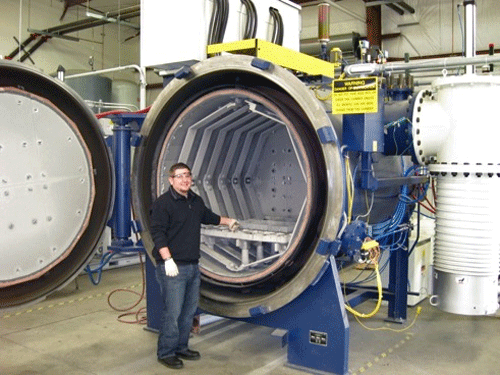Vacuum Process Technology (Number 2); An over view of the Technology presented by David Pye of Pye Metallurgical International Consulting
Trends and developments in vacuum furnace technology
An overview of the technology
New technologies seem to center around a paradox; on the one hand they are welcomed as better methods to attain much improved and better results, and an enhanced quality of life. Yet on the other hand some industries resist and decry the new process technological methods. Amid the rapid revolution of material science, yet there are those who swear by the new technologies and who will invest every source possible in that technology to make their operations more productive, quality – oriented and more importantly, profitable.
Vacuum furnace processing technology has a tremendous potential, it has reached what one can consider maturity in relation to other international trends. It is a technology that will assist material scientists and their industrial associates to move into the third millennium. But first there are a few problems to address.
Observations of the vacuum processing technology
The main processes today that are using vacuum technology for metallurgical enhancement of their products are;
- Low-pressure carburizing (also known as the vacuum carburizing)
- Vacuum plasma carburizing.
- Plasma nitriding (also known as low pressure nitriding, pulsed Plasma nitriding, ion nitriding). Each one is using the technology of low pressure (vacuum) However, one has to be careful at the low-pressure selection for these processes.
- Chemical vapor deposition (also known as C V D). This is a deposition type process which can be integrated into a plasma nitriding system, whereby the nitriding is the initial procedure (which is a thermochemical diffusion technology and on completion and still in the same furnace, one can then continue with the deposition procedure for CVD).
- Physical vapor deposition known as PVD
Typical applications of these processes are for high wear (such as drills, Hobbs, milling cutters, and corrosive environments. The aerospace industry has seen fit to use these procedures for high-strength, lightweight materials, which embrace the use of additional metals such as titanium to achieve longer life than is normally associated with the more conventional furnace processes.
Pursuit of better materials.
Low pressure conditions, or vacuum technology can be used easily on the more exotic materials as well as the lower grade materials to enhance the operational quality.
One can add compounds or elements to change and improve molecular structures and Metallurgical operational results. A typical example could be the use of carbon diffusion in the case of case hardening.
Observing the aircraft and armaments industries for example, where heat treatment plays both a significant and vital role in assisting manufacturers to achieve specifications and to ensure that their products meet with guaranteed acceptable degrees of safety, reliability, and durability.
The general industrial prognosis is that heat treatment (total Metallurgical enhancements) will become an increasingly critical aspect in the pursuit of higher and better materials technologies.
Likewise, the heat treater’s role and status will also increase in importance. The automotive industry is another sector in which we can expect (and now beginning to see) a significant even illusionary process in the field of heat treatment and surface modification.
There is still a great challenge to accomplish lighter weight materials of the vehicles, while retaining and an improvement in their operational strength.
What does the future have in store in searching for the Holy Grail of materials technology and processing?
The current generation of automobiles on now featuring higher percentages of ceramics deposition and or a more effective use of carbon the enforce carbon fibers. The basic car design which encompasses high wear and the need for improved performance, while still retaining most of the basic shapes of the automobiles.
We may be close to witnessing the death of steel as we have known it as well as a decline in the use of conventional metallurgical enhancement technologies. What we are beginning to see is the birth of new processing technologies, new materials and new applications. Central to this, it is my belief that this will bring vacuum processing technology into the forefront of metallurgical heat treatment.
I also foresee even with conventional heat treatment of processing technology operations, a transition into a range of vacuum related processes and moving into the workshops of the contract heat treater with the specialized metallurgical processing and metal surface treatment knowledge.
Even if the in-house heat treatment operations of finding it increasingly difficult each day to:
- Recruit specialized labor
- some tendency not to invest in high capital processing equipment.
- The ability to maintain the equipment both mechanically and electronically (simply because of the PC/PLC process control combinations, and in some cases, to shut down the equipment for routine and preventative maintenance.
It is believed that within the next 10 years, more of the commercial heat treaters will develop themselves in the field of vacuum heat treatment processing such as hardening/tempering and as the need develops, for a cleaner more consistently heat-treated product.
In addition to this the right to foresees that commercial heat treatment companies will develop rapidly into the field of vacuum brazing on a contract basis. This will embrace the brazing industry with specialized materials that demand absolute clean processing conditions for both ferrous and nonferrous materials (particularly aluminum materials for brazing), Sintering.
As far as surface treatments are concerned, using vacuum technologies (with the exception of plasma nitriding), it is believed that the larger companies involved in strategic products will tend to explore the benefits of the vacuum related surface modification procedures such as chemical vapor deposition, physical vapor deposition, plasma assisted vapor deposition, vacuum carburizing, vacuum carbonitriding and ion implantation.

